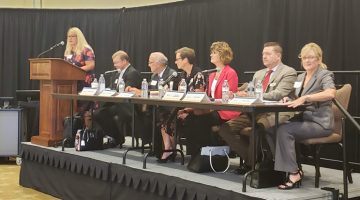by Chris Watts
Black Friday has never been one of my favorite holiday traditions – the thought of fighting the crowds inspired more agoraphobic ambivalence than bargain-hunting excitement. The convenience of Cyber Monday was more my speed…and now COVID has pushed even more shoppers from the local mall to the Amazon marketplace.
Estimates from last Friday confirm that deal-hunting went digital during the pandemic, as consumers spent $9 billion online (up 22% from 2019). This makes it the second-biggest online shopping day in history. The largest? Monday claims the top spot, as virtual checkouts rang up nearly $11 billion.
Like most states, Indiana’s finances have been shaken by the COVID crisis. Sales taxes contribute nearly half the state’s general fund revenues; what’s the fiscal impact of this accelerated shift from bricks-and-mortar to online retail during this year of economic disruption and social distancing?
Fortunately, Hoosiers can look back to the 2019 session of the General Assembly for action blunting some of the budget impact of COVID. The year before, the U.S. Supreme Court (in South Dakota vs. Wayfair, Inc.) clarified that states can collect sales taxes from out-of-state sellers, even if they lack a physical presence in that state.
The legislature followed up that decision by advancing a plan putting the responsibility to collect state sales taxes on third-party market facilitators like Amazon. The policy focused on fairness – why should Amazon sales be “tax free” while Indiana businesses are enlisted as tax collectors? – and also aimed to expand the state’s revenue base as online shopping continued to grow as a share of total sales.
This provision was initially introduced on its own (Senate Bill 322, co-authored by Senators Travis Holdman and Erin Houchin), but was ultimately amended into the state budget in the waning days of the 2019 session and signed into law.
The move was noted at the time as a win for the state’s bottom line. The original fiscal note for SB322 projected up to $150 million in additional sales tax revenues in FY2020 and 2021 from the market facilitator adjustment. A few months later, the December 2019 revenue forecast boosted the predicted impact to over $250 million (also factoring in modest new collections made possible by enforcement of the Wayfair decision).
Sales taxes were outperforming even these optimistic predictions through the first months of 2020 – and we all know what happened next, as COVID derailed the economy and sent revenues into a tailspin. Sixteen months into the current budget cycle, the general fund remains $515 million below forecasts due to the impacts of the COVID crisis.
The majority (about 60%) of this shortfall is from individual income taxes, as COVID-related business closures and cutbacks sent Indiana unemployment soaring from 3% in March to 17.5% in April, before settling back to 5% in October. With the current surge of cases, Hoosiers face renewed pressure to stay home and cautionary restrictions on employers, which could stall taxable earnings.
But sales taxes – Indiana’s largest revenue source – have been relatively steady and even edged above monthly forecasts since June. Federal enhancement of unemployment benefits has supported consumer spending, and pent-up retail activity seemed to accompany the re-opening of the economy in mid-late summer. But Indiana’s capacity to include online transactions in the tax base also deserves a fair share of the credit.
The State Budget Committee reviews the initial FY2022-23 revenue forecast in less than two weeks, setting up the challenging task of building a state budget during a global pandemic. The 2019 changes to the tax code couldn’t have anticipated today’s public health emergency, but certainly have added some stability to an uncertain fiscal outlook. (For a quick footnote, continue reading below.)
Chris Watts is the director of the Indiana Fiscal Policy Institute.











